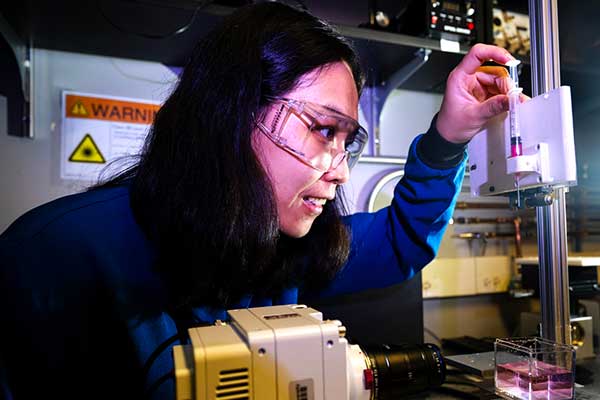NSF CAREER Award for Impact Dynamics of Complex Fluid Droplets on Surfaces

MIE Assistant Professor Xiaoyu Tang received a $584,946 NSF CAREER award for “Unraveling Flow-Fluid Coupling During Impact of Complex Fluid Droplets.” The research will establish a framework that combines several state-of-the-art diagnostic methods to probe the impact dynamics of drops composed of complicated fluids. Data will provide critical insight into the impact dynamics of complex fluid droplets on surfaces.
This article originally appeared on Northeastern Global News. It was published by Cesareo Contreras. Main photo: Xiaoyu Tang, Northeastern professor of mechanical and industrial engineering and chemical engineering performs research on liquid droplets. Photo by Alyssa Stone/Northeastern University
3D printers could become more precise because of this Northeastern professor’s research on water droplets
Inkjet printers have been around since the late 1980s, but they’ve improved leaps and bounds since their introduction more than 30 years ago.
On one hand, they are an engineering marvel — millions of multi-colored ink droplets are precisely deposited onto a blank piece of paper to produce everything from written reports to colorful invitations.
But on the other hand, the opportunities for disruption are still profound, especially for more complex printing jobs involving large 3D structures and multiple types of materials.
At Northeastern University, Xiaoyu Tang, a mechanical and industrial engineering professor, is helping drive innovation in the space at the university’s Multiphase Transport Research Lab.
As principal investigator, Tang leads a team of researchers focused on understanding materials that operate at the intersection of fluid and solid states — materials that tie directly to the technology inside your printer
Thanks in large part to a recently awarded NSF Career Award grant, Tang and her team will soon begin the process of developing a new framework to better understand the fluid dynamics at play when droplets of water filled with particles are dropped into bodies of liquid.
This work, Tang says, could help engineers design more robust and optimized ink processes and more resilient printing hardware.
The research itself will involve some pretty high-tech pieces of equipment, namely high-speed cameras capable of capturing 10,000 images in one second.
That level of speed is a necessity, Tang explains.
“The impact process [of the droplet hitting the water] will only be under a hundred milliseconds,” she says.
Read full story at Northeastern Global News